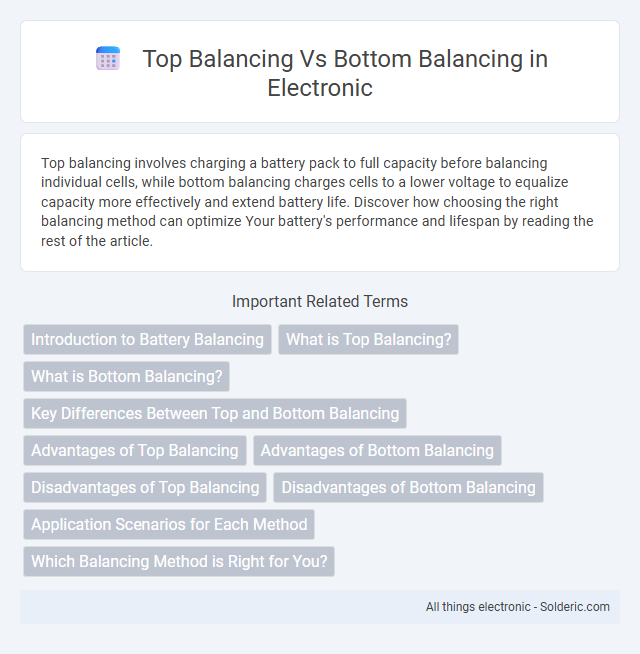Top balancing involves charging a battery pack to full capacity before balancing individual cells, while bottom balancing charges cells to a lower voltage to equalize capacity more effectively and extend battery life. Discover how choosing the right balancing method can optimize Your battery's performance and lifespan by reading the rest of the article.
Comparison Table
| Feature | Top Balancing | Bottom Balancing |
|---|---|---|
| Definition | Charging battery to the highest voltage level evenly across cells. | Discharging the highest voltage cells to match the lowest voltage cell. |
| Method | Limits cell voltage at the top during charge. | Discharges cells at the bottom to balance all cells. |
| Advantages | Maximizes battery capacity and range. | Extends battery life by avoiding overcharge. |
| Disadvantages | Risk of cell imbalance during discharge. | Reduced usable capacity due to lower charge level. |
| Best Use | Electric vehicles focused on maximum range. | Energy storage systems prioritizing longevity. |
| Impact on Battery | Higher stress on top cells, potential degradation. | Lower stress, better cell aging uniformity. |
Introduction to Battery Balancing
Battery balancing ensures uniform charge levels across individual cells in a battery pack, preventing overcharging or undercharging that can reduce performance and lifespan. Top balancing charges all cells to the same maximum voltage before use, enhancing capacity utilization in fully charged states. Bottom balancing equalizes cells at their minimum voltage, improving safety and extending cycle life by preventing deep discharge damage.
What is Top Balancing?
Top balancing is a battery management technique that equalizes the voltage of individual cells by discharging the higher voltage cells to match the lower ones, ensuring uniform charge levels across the pack. This method helps prevent overcharging of any single cell, thereby extending battery life and maintaining optimal performance. Understanding top balancing can enhance your battery maintenance strategy by promoting safer and more efficient energy storage.
What is Bottom Balancing?
Bottom balancing is a method of setting a lithium-ion battery's state of charge (SOC) fully discharged at zero volts before installation to ensure all cells start from the same baseline capacity. This technique helps prevent over-discharging individual cells, promoting longer battery life and better overall pack performance by aligning the cells at their lowest charge state. By choosing bottom balancing, you enhance battery safety and consistency, especially in electric vehicles and energy storage systems.
Key Differences Between Top and Bottom Balancing
Top balancing involves charging all battery cells to the same voltage at full capacity, ensuring uniform maximum charge levels, which prevents overcharging but may limit usable capacity. Bottom balancing equalizes cells at a low voltage near the battery's minimum state of charge, maximizing usable capacity and enhancing battery lifespan by avoiding deep discharge of weaker cells. The key difference lies in their balancing points: top balancing prioritizes protection at full charge, while bottom balancing focuses on safe discharge and capacity optimization.
Advantages of Top Balancing
Top balancing maximizes battery capacity by ensuring each cell reaches full charge individually, which leads to higher overall battery efficiency and extended lifespan. This method prevents overcharging and improves state-of-charge accuracy across all cells, enhancing safety and reliability in battery management systems. By maintaining uniform cell voltages at peak charge, top balancing supports optimal energy utilization in applications like electric vehicles and renewable energy storage.
Advantages of Bottom Balancing
Bottom balancing offers superior accuracy in state-of-charge (SOC) estimation because it balances cells at their fully discharged voltage point, minimizing measurement errors associated with cell voltage variances. This method enhances battery longevity and safety by ensuring that all cells reach the true empty state simultaneously, preventing over-discharge in individual cells. Consequently, bottom balancing improves battery pack reliability and overall performance in electric vehicles and energy storage systems.
Disadvantages of Top Balancing
Top balancing in battery management can lead to uneven cell aging and reduced overall battery capacity due to frequently discharging higher-voltage cells to match lower-voltage ones. This method increases energy loss as excess charge is dissipated as heat, impacting efficiency and potentially causing thermal management issues. Understanding these disadvantages helps you choose optimal balancing techniques for extending battery lifespan.
Disadvantages of Bottom Balancing
Bottom balancing poses the disadvantage of inaccurate state-of-charge (SOC) readings, leading to potential over-discharging and battery damage. This method can cause the battery management system to underestimate the battery's capacity, resulting in reduced performance and premature degradation. You may experience unreliable battery health monitoring and diminished overall lifespan when relying on bottom balancing.
Application Scenarios for Each Method
Top balancing is ideal for lithium-ion battery packs in electric vehicles where precise state-of-charge (SOC) equalization extends battery lifespan and optimizes performance during high-demand applications. Bottom balancing suits battery systems used in energy storage or electric bicycles, where ensuring all cells reach the same low voltage threshold prevents over-discharge and enhances safety. Selecting top or bottom balancing depends on factors like battery chemistry, application cycle, and operational safety requirements.
Which Balancing Method is Right for You?
Top balancing evenly distributes charge among battery cells by fully charging the entire battery pack to the highest cell voltage before balancing, ensuring maximum capacity and battery longevity. Bottom balancing sets each cell to the same state of charge at a lower voltage, enhancing safety and preventing over-discharge during use, which can be ideal for systems emphasizing battery protection. Your choice depends on whether maximizing capacity (top balancing) or prioritizing safety and cycle life (bottom balancing) aligns better with your battery usage and performance needs.
Top balancing vs Bottom balancing Infographic

 solderic.com
solderic.com